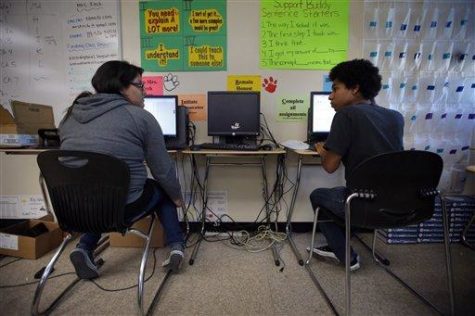New Learning Options Come to HHS
April 10, 2017
Students could skip half of their class time.
Beginning in the 2017 to 2018 school year, Hershey High School will be offering “blended learning” for select classes throughout the school. Far from the traditional classroom experience, blended learning classes offer many new options that are unavailable in a normal classroom setting.

Essentially, “blended learning” refers to meeting with a teacher every other day and having a study hall during which a student completes work for the course on the off days, according to the HHS Flexible Learning page. Despite half the typical amount of class time, there is still the same amount of work as a normal class, and the course content is generally the same as its traditional learning counterpart.
The only major difference between blended and traditional courses is that every other day students would do their work in one of the learning commons areas, which are areas where students will have technology, materials, and tutoring available to them.
Unlike a traditional classroom setting, students will only see their teacher three times a cycle. Although if a student is struggling, the teacher is available to provide extra help as needed just as in a regular classroom. On the off days, teachers may pull students from their normal place in the learning commons to provide extra help.
According to HHS English teacher Erin Ives, who has been involved in the development of the new blended learning programs, students will gain a better opportunity to “come in and get some personalized attention from their teachers.”
However, most students will only meet with the teacher three times a cycle, so there are some suggested characteristics to have if a student wants to be in a blended class. On the HHS Flexible Learning Page, it is suggested that those taking blended classes be self-motivated and independence.
There are many benefits to this type of learning. Although it would help to be an independent and motivated student before trying blended learning, a student can learn these skills through blended learning. In blended learning, students are granted with more flexibility and preparation for learning outside of high school. The HHS Flexible Learning Page says that students will also be able to move at their own pace instead of the pace of other learners in their class.
Although there are many benefits to blended learning, Ives wanted it to be clear that “blended learning is not for everyone.”
She believes that the students who excel in a traditional classroom might not benefit from being in a blended class. Ives also said that “students who are more independent learners” or are pulled out of class for various reasons (music lessons, internships, etc.) would greatly benefit from the blended program as they can choose when they do their learning.
While there are many benefits to blended learning, there are also some downfalls. Ives said that students who can self-advocate, self-learn, and manage time will be able to do well in a blended format. In contrast, success in blended courses would be more difficult for a student without these skills. Ives believes this idea is especially true for students who use teachers as motivation for class productivity.
There will be 17 classes offered in a blended style. These classes include an assortment of English, Spanish, science, math, technology, and library classes. The classes will only be offered in a blended style if there is enough student demand; if not, students will be placed in the traditional counterpart of the blended class.
According to Ives, the best thing a student who is considering blended learning can do is “ask any questions if they are unsure that this is the right path for them to take.”







